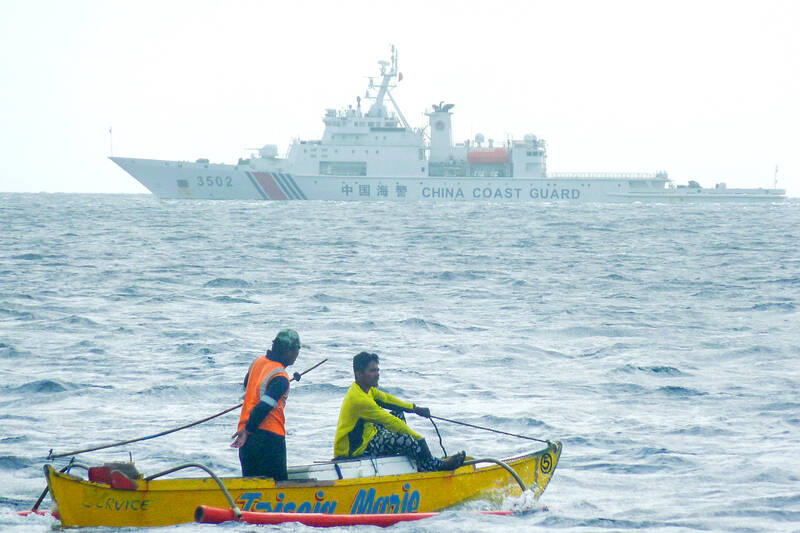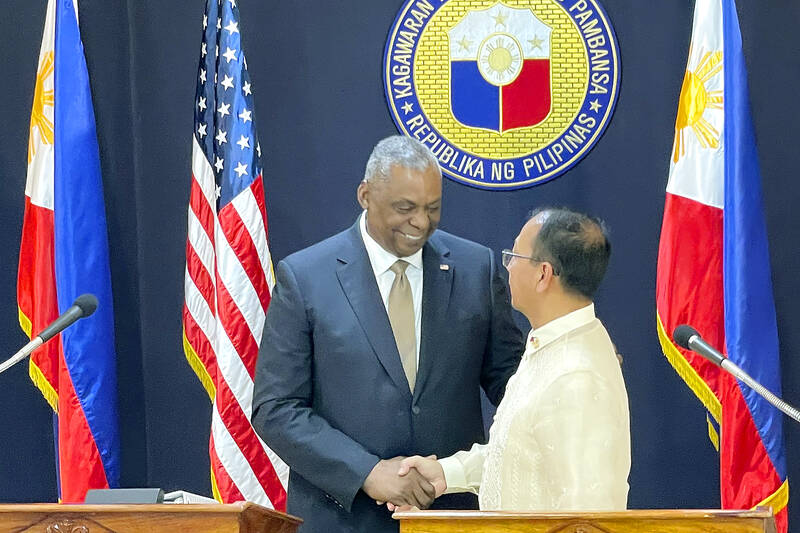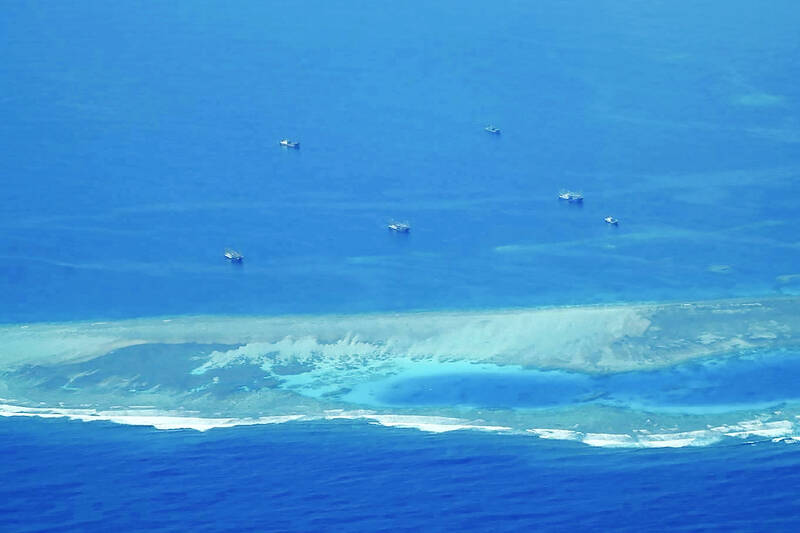Under the Enhanced Defense Cooperation Agreement (EDCA) between Washington and the Manila, the US is going to gain access to four bases in the Philippines, two or three most likely in Cagayan and Isabella provinces in northern Luzon.
Although officials in both countries said in a joint statement that “The addition of these new EDCA locations will allow more rapid support for humanitarian and climate-related disasters in the Philippines, and respond to other shared challenges,” these bases are obviously aimed at conflict over Taiwan, just 250km away.
The agreement also supported the completion of work at five bases the US already has access to.

Photo: AFP
Last week Senator Imee Marcos, the daughter of dictator Ferdinand Marcos and older sister of President Bongbong Marcos, questioned officials on the new agreement and the base locations, saying “I just need to understand why are you choosing all these sites in Northern Luzon when in fact if it were West Philippine Sea deterrence that were uppermost in our minds, the protection of our territorial sovereignty, surely it should be in the western sector not purely in the northern.”
CHINESE EXPANSIONISM
“West Philippine Sea” is how the South China Sea is referred to in the Philippines. The previous administration had been close to China, while the current one has shifted towards the US. At least part of that reason is Chinese expansionism in the area.

Photo: AP
The issue of Chinese expansion is not taken lightly in the Philippines, and is not the province of a particular party or intellectual school. For example, Walden Bello, longtime leftist writer, politician and intellectual (and author of Dragons in Distress, on environmental and social problems in the newly developed Asian economies in the 1980s), journeyed out to the Spratly Islands (Nansha Islands, 南沙群島) in 2011 to challenge China. Bello wrote in The Rappler in 2017: “Our mission: affirm our country’s sovereignty over nine islands and maritime formations in our possession amidst China’s increasingly aggressive behavior in the area.”
In March of 1956 Filemon Cloma led an expedition of Filipinos to the Spratlys and claimed a section of the area as a microstate called Freedomland (not to be confused with another section of the Spratlys called the Principality of Freedomland, established by a French swindler). His brother Tomas Cloma Sr declared the Free Territory of Freedomland in the area, establishing the capital and government on Flat Island (Patag Island).
ROC EXPANSIONISM

Photo: AFP
This microstate was effectively terminated in October of 1956 by two Republic of China (ROC) naval ships, which burned the structures that had been erected. Interestingly, during that expedition, as Francis-Xavier Bonnet has chronicled, the ROC naval ships left fake markers on islands in the Spratlys dating from 1946.
To this day the ROC still claims the South China Sea, confusing commentators who often falsely present this claim as if “Taiwan claims…” China’s notorious “nine-dash line” is, after all, an invention of the expansionist ROC adopted by the expansionist People’s Republic of China (PRC). ROC troops currently occupy Itu Aba Island (Taiping Island, 太平島), while China illegally occupies numerous islands and features in the area.
Similarly, certain authorities in the Philippines argue that Cloma’s claims have been inherited by the Philippines, since they compelled him to sell them for a single peso. One of Manila’s arguments is that since Japan renounced its claim to the islands in the San Francisco Peace Treaty, the islands became res nullius and anyone’s for the taking, and Cloma legally took them.

Photo: AP
In fact, in the 1930s far-sighted Filipino thinkers begged the US to claim the Spratlys on Manila’s behalf, but the US declined.
ARCHIPELAGIC NATIONS
The first article of the 1987 Philippines Constitution defines Philippine territory as an archipelagic nation and specifically includes the waters above and the seabed below its land territories. The Philippines thinks of itself as an oceanic state in a way that Taiwan should, but does not because the Han-centric thinkers who dominate Taiwan’s policy thinking come from a culture that traditionally has no connection to the sea.
Thus, another argument of the Philippines is that as an archipelagic state, it can claim a 200 mile exclusion zone, which includes the islands. China, which is not an archipelagic state, cannot claim them.
The idea of the Philippines as an oceanic state, and Imee Marco’s recent comments, are a reminder of how important the territory issue is to Filipinos of all political stripes. Bello’s 2017 piece was in response to then-president Rodrigo Duterte’s announcement that he would not be visiting Pagasa Island (Thitu Island) out of fear of offending China.
Critical of Duterte’s decision, Bello observed: “Practically the whole country supported the president’s initial decision to raise the flag at Pagasa. There was great relief that the policy of appeasing the beast was finally over.”
The PRC’s passage in 2021 of a law authorizing Chinese Coast Guard ships to use “all necessary means” against foreign vessels to enforce its territorial claims was termed a “verbal threat of war” by then-foreign secretary and current Philippine Ambassador to the UK Teodoro Locsin Jr. That’s exactly what it was.
As an aside, people who argue that we are far from war in Asia should consider the prospect of war erupting out of some peevish China aggression, such as lasering foreign ships and planes. China may not be planning a war in the near term, but that does not mean one can’t happen.
The ROC claims and island occupations in the South China Sea touch upon strongly held sensibilities, and unlike scholars or some Taipei Times commentators, Filipinos are not likely to make fine distinctions between Taiwan and the ROC.
SOUTH CHINA SEA RECONSIDERED
The recent agreements and rapprochement between Washington and Manila signal the latter’s role in any China conflict. Washington will be flying planes from bases there to interdict Chinese movements against Taiwan. Because Japan and the US Pacific territories are so distant, it is likely that such supplies as reach Taiwan will have to be brought up through the Philippines.
Taipei needs to be reconstructing and hardening its ports and transport systems on the east coast to handle wartime logistics requirements. It might also consider investments in logistics infrastructure in Luzon to complement these needs. Certainly Washington would welcome such proactive moves.
That would mean treating Southeast Asian nations as more than just suppliers of cheap labor, but as potential allies.
All this implies that Taipei should be thinking about uncomplicating the South China Sea situation with an eye toward future cooperation with Manila. Filipinos are not going to be happy about sacrificing for a state that squats on their sovereign territory.
It’s long past time Taipei thought about handing Itu Aba over to Manila and giving up its useless claims to the South China Sea, which bring nothing but headaches to the nation’s military planners and nothing but friction to its relationships with desperately needed neighboring states.
At some point, Taiwan will be a recognized independent state and the ROC will cease to exist as a ghostly avatar of China. These claims will then be a dead letter.
Kill them now, while we can still get something for them.
Notes from Central Taiwan is a column written by long-term resident Michael Turton, who provides incisive commentary informed by three decades of living in and writing about his adoptive country. The views expressed here are his own.

In the March 9 edition of the Taipei Times a piece by Ninon Godefroy ran with the headine “The quiet, gentle rhythm of Taiwan.” It started with the line “Taiwan is a small, humble place. There is no Eiffel Tower, no pyramids — no singular attraction that draws the world’s attention.” I laughed out loud at that. This was out of no disrespect for the author or the piece, which made some interesting analogies and good points about how both Din Tai Fung’s and Taiwan Semiconductor Manufacturing Co’s (TSMC, 台積電) meticulous attention to detail and quality are not quite up to

April 21 to April 27 Hsieh Er’s (謝娥) political fortunes were rising fast after she got out of jail and joined the Chinese Nationalist Party (KMT) in December 1945. Not only did she hold key positions in various committees, she was elected the only woman on the Taipei City Council and headed to Nanjing in 1946 as the sole Taiwanese female representative to the National Constituent Assembly. With the support of first lady Soong May-ling (宋美齡), she started the Taipei Women’s Association and Taiwan Provincial Women’s Association, where she

It is one of the more remarkable facts of Taiwan history that it was never occupied or claimed by any of the numerous kingdoms of southern China — Han or otherwise — that lay just across the water from it. None of their brilliant ministers ever discovered that Taiwan was a “core interest” of the state whose annexation was “inevitable.” As Paul Kua notes in an excellent monograph laying out how the Portuguese gave Taiwan the name “Formosa,” the first Europeans to express an interest in occupying Taiwan were the Spanish. Tonio Andrade in his seminal work, How Taiwan Became Chinese,

Mongolian influencer Anudari Daarya looks effortlessly glamorous and carefree in her social media posts — but the classically trained pianist’s road to acceptance as a transgender artist has been anything but easy. She is one of a growing number of Mongolian LGBTQ youth challenging stereotypes and fighting for acceptance through media representation in the socially conservative country. LGBTQ Mongolians often hide their identities from their employers and colleagues for fear of discrimination, with a survey by the non-profit LGBT Centre Mongolia showing that only 20 percent of people felt comfortable coming out at work. Daarya, 25, said she has faced discrimination since she